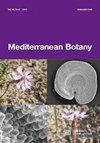格雷多斯地区公园泥炭地的多样性和保护(西班牙伊比利亚中央系统):地貌和地学特征和即将到来的威胁
IF 0.7
4区 生物学
Q3 PLANT SCIENCES
引用次数: 1
摘要
高山泥炭地是栖息地、生物多样性、水和碳循环的重要生态系统,但伊比利亚中部几乎没有全面的信息。我们介绍了关于格雷多斯地区公园(伊比利亚中央系统)泥炭地的分布、地理形态、区系、地理植物学和栖息地多样性的研究结果。我们确定了72个泥炭地,面积117公顷,面积从0.01到17.34公顷。泥炭地主要分布在海拔1775–2230 m的上亚热带生物气候带。从地貌的角度,定义了9种不同的泥炭地类型。对103个相关物种进行的多元分析(聚集聚类分析和主成分分析)使我们能够将采样的泥炭地林分分为7个植物群落和4个欧洲栖息地,这些群落是在复杂的水文地貌条件下形成的,并提出了一个新的先前描述的其他群落的亚群落(Caricetum echinato nigrae lypodielletosum indatae)。对Gredencean泥炭地的主要威胁是牧业压力,牧业压力对其中15个泥炭地产生了强烈影响,主要发生在上层上层和下层或下层生物气候带之间(约1314–1700 m asl)。格雷多斯地区公园泥炭地中记录的7种苔藓植物和3种维管植物被列入国际自然保护联盟红色名录。从保护优先权的角度来看,最受威胁的是生长在非营养和矿物营养泥炭地(Caricion nigrae植被)的过渡沼泽群落(生境7140)。特别是,伊比利亚中央系统特有的Sedo lagascae Eriophoretum latifolii协会是在这方面考虑的五个标准中得分最高的一个,因为Meesia triquetra是一种“极度濒危”物种。本文章由计算机程序翻译,如有差异,请以英文原文为准。
Diversity and conservation of the Gredos Regional Park peatlands (Iberian Central System, Spain): Geomorphological and geobotanical characterisation and incoming threats
High-mountain peatlands are essential ecosystems for habitats, biodiversity, water, and carbon cycling, butthere is little comprehensive information in central Iberia. We present results of research concerning the distribution,geormorphology, floristic, geobotany, and habitat diversity of peatlands in the Gredos Regional Park (Iberian Central System).We identified 72 peatlands covering 117 ha and ranging in size from 0.01 to 17.34 ha. Peatlands occur primarily in theupper orosubmediterranean bioclimatic belt at 1775–2230 m asl. From a geomorphological point of view, 9 differentpeatland typologies have been defined. Multivariate analyses (agglomerative cluster analysis and principal componentanalysis) of 103 relevés allowed us to classify the sampled peatland stands into 7 plant communities and 4 Europeanhabitats that formed along complex hydrogeomorphic conditions, and to propose a new subassociation of other communitypreviously described (Caricetum echinato-nigrae lycopodielletosum inundatae). The main threat to Gredenseanpeatlands is pastoral pressure, which affects 15 of them intensively, mainly between the upper supramediterranean andthe lower orosubmediterranean bioclimatic belts (~1314–1700 m asl). Seven bryophytes and three vascular plantsdocumented in the Gredos Regional Park peatlands are included in the IUCN Red List. From the point of view ofconservation priority, the most threatened correspond to transition mires communities (Habitat 7140) growing inoligotrophic and minerotrophic peatlands (Caricion nigrae vegetation). Particularly, the Iberian Central System endemicSedo lagascae-Eriophoretum latifolii association is the one that has achieved the highest score in the five criteriaconsidered in this regard because Meesia triquetra, a species with the category of “critically endangered”, inhabits it.
求助全文
通过发布文献求助,成功后即可免费获取论文全文。
去求助
来源期刊

Mediterranean Botany
Agricultural and Biological Sciences-Plant Science
CiteScore
2.40
自引率
10.00%
发文量
30
审稿时长
12 weeks
期刊介绍:
Mediterranean Botany (ISSNe 2603-9109), formerly Lazaroa, is a biannual journal that publishes original research studies in the field of Botany including plant systematics, vegetation ecology, biogeography, evolutionary biology, ecophysiology, community ecology, ethnobotany and conservation biology on Mediterranean biomes but also in interacting areas.
Mediterranean Botany is an OPEN ACCESS Journal, free of charges for any published article.
 求助内容:
求助内容: 应助结果提醒方式:
应助结果提醒方式:


